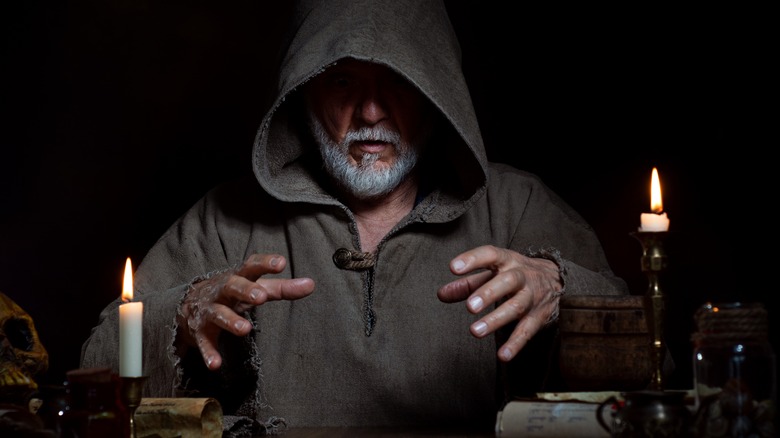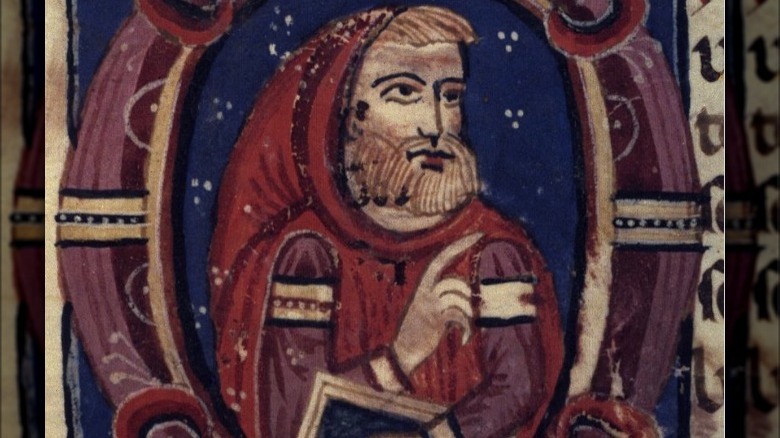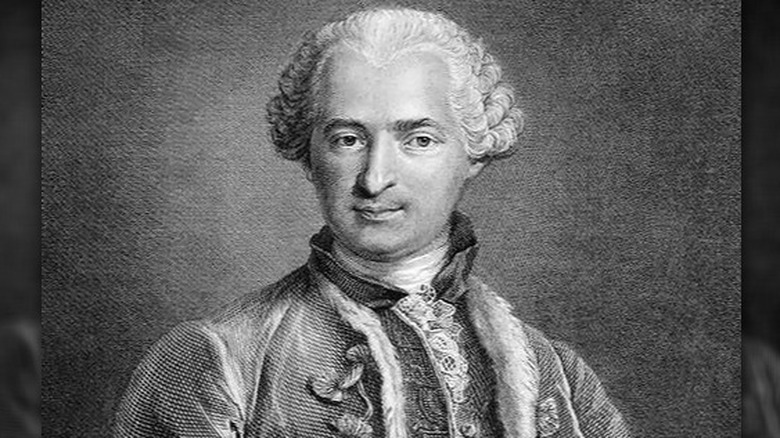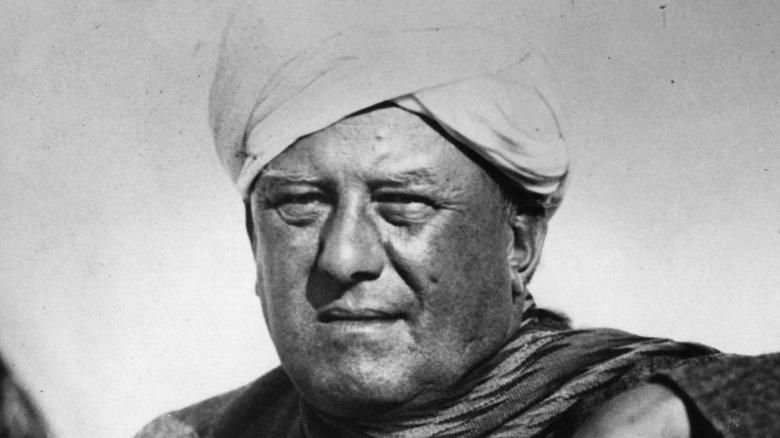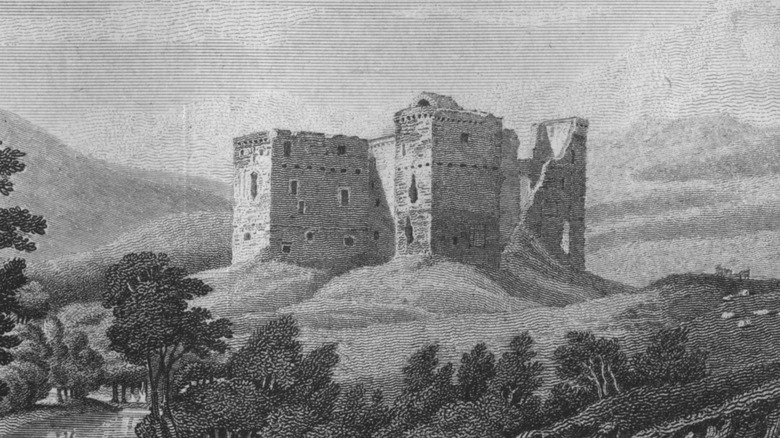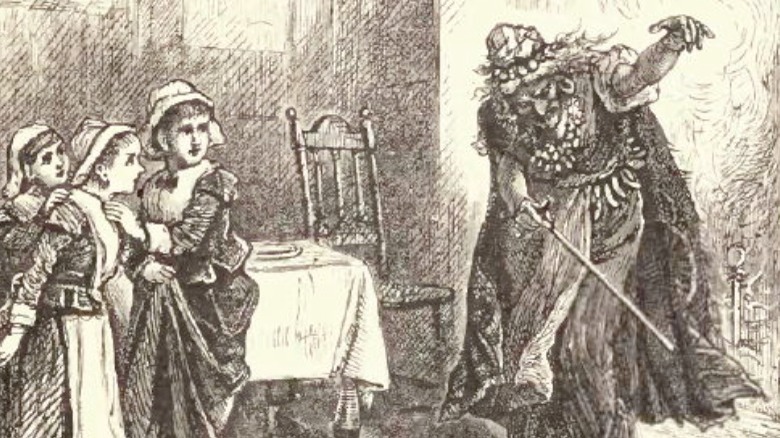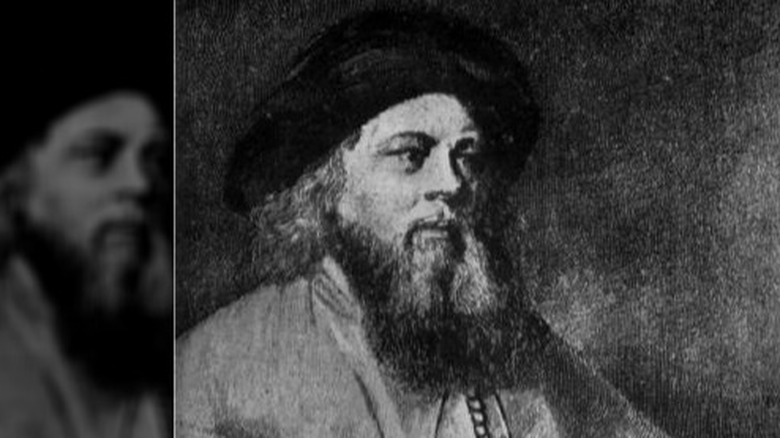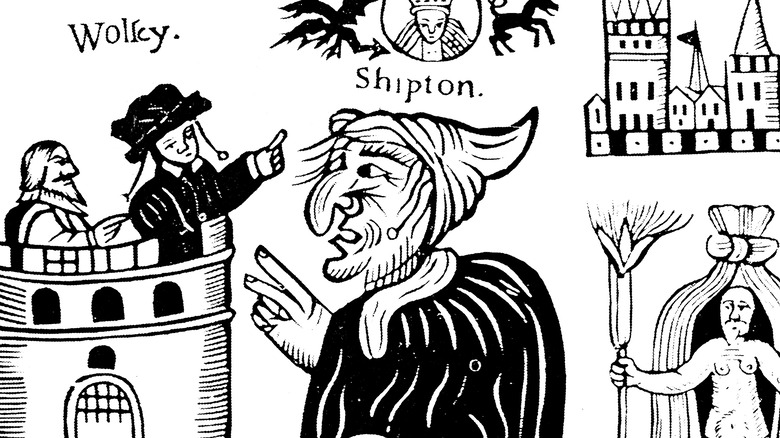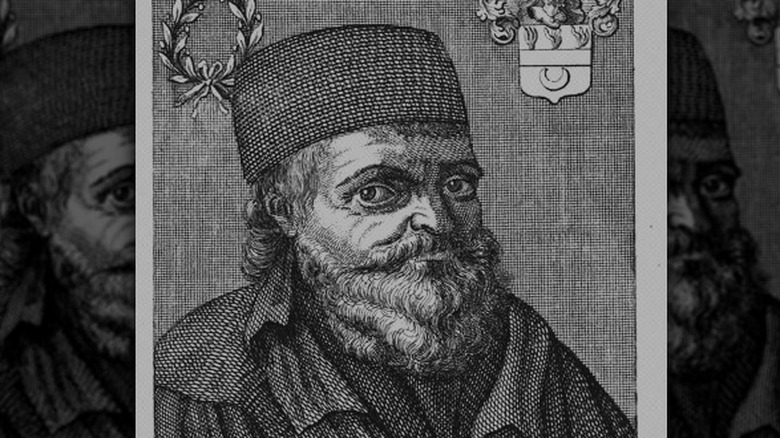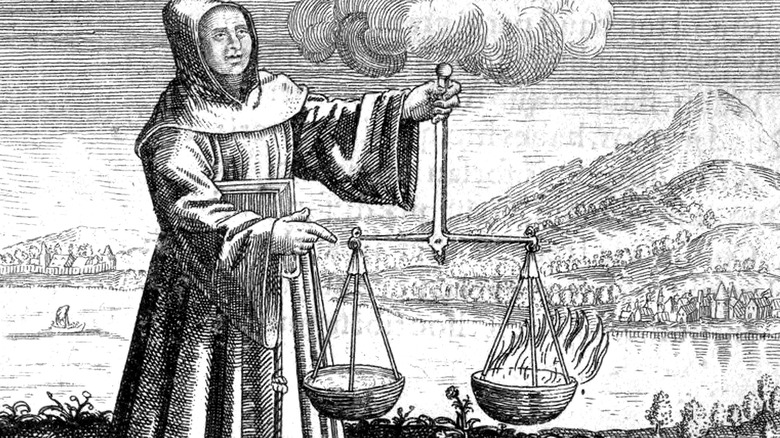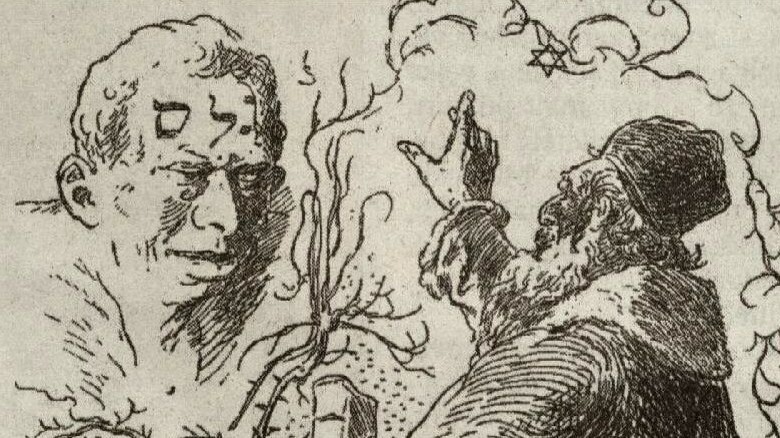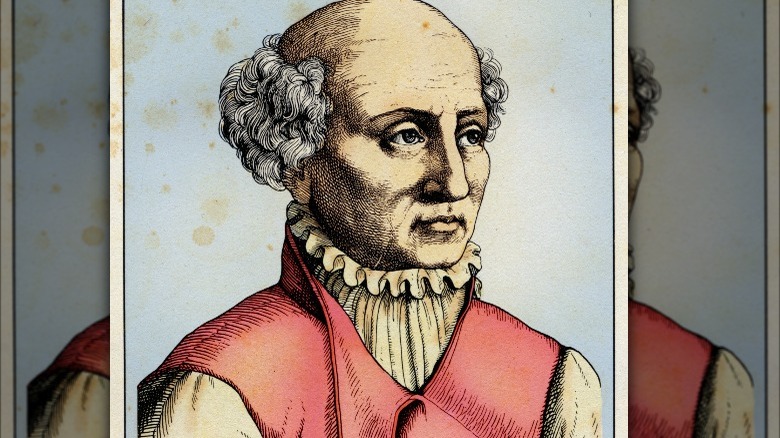Real-Life Witches And Wizards That Actually Existed
Outside of the fantasy realm of fictional stories like "Harry Potter" and "Hocus Pocus," the actual existence of witches and wizards is not an established belief. Even big moments in history, like the Salem Witch Trials, proved to be nothing like what they tried to be. They didn't expose witches so much as they let panic drive people to cruelty and torture that would lead anyone to confess to anything, just to get it all to stop.
So that leads us back to the question of whether or not witches and wizards actually existed. Are there actual Gandalfs and McGonagalls in the annals of history? Apparently so: Maybe they weren't dueling enormous, flaming beings, or twirling wands in wrist-snapping combat, but they were doing things that few understood, many questioned, and many more still identified as magic. Unfortunately for them, magic does not have a great reputation in history. There was a time when math was considered heretical because it was misunderstood. Practically any form of science that pushed the boundaries of the church's teachings was branded as magic and punishable by all the awful things the church used to punish people that threatened their power — including being burned at the stake, per History.
This means that hindsight certainly takes a good deal of historical "wizards" and places them instead in the realm of "science," but that doesn't discount how magical they were in their day. Here's a look at some witches and wizards that actually existed.
Himiko
Japan has long been ruled by a line of men descended from divinity — at least, that's how ancient historical legends tell it, per Britannica. But in the early stages of Japanese history, long before it was a unified nation, there was a Queen by the name of Himiko or Pimiko, who does not appear in any Japanese historical records, but does appear in the histories of neighboring Korea and China.
The other problem with Himiko's history is that it came before Japan had writing, according to UMSL Daily, but what is known about her spans the gambit from historical and provable, to legend and hearsay. According to "In Pursuit of Himiko. Postwar Archaeology and the Location of Yamatai," along with ruling her domain, Himiko practiced sorcery, including bewitching her own people. She also lived in a palace surrounded by 1,000 female attendants and armed guards that ensured that she was never seen, according to World History Encyclopedia.
All of these factoids contribute to a fairly hefty legend, but UMSL Daily directs attention to her known historical facts: She unified Japan and initiated international diplomacy for the first time — in addition to being a shaman who practiced divination.
Michael the Scot
The only Scotsman to be mentioned in Dante's Inferno, Michael Scott, didn't get there by being a Bible-toting Christian. Instead, he was pictured in the eighth circle of hell, getting tortured in unspeakable manners. How he got there is a matter of some speculation, but it begins with Michael being a well-traveled man of Europe, who learned many languages and became a skilled translator, according to The Scotsman. He began translating Arabic texts, as well as the teachings of Aristotle, into Latin. Around the same time, he began sporting Arabic attire, which to a xenophobic 13th-century Europe was nothing short of proof that this Michael guy was a wizard, no doubt about it.
Along with studying alchemy, science, math, and the occult, one of Michael's supposed main powers was being able to see the future. In fact, he saw the future so clearly that he believed he knew how he was going to die — a pebble was going to fall on his head. To assist in his prolonged life, he wore an iron cap at all times, according to The Scotsman. But legends say his powers went even further, including cleaving the earth to form mountains, and changing the direction the River Tweed flowed.
In the end, when he died — reportedly from taking off his iron cap during church and suffering a pebble striking him in the head — he was buried with his magical books, as all good wizards probably are.
The Count of St. Germain
Voltaire referred to the count of St. Germain as "a man knows who everything and who never dies," according to "Saint Germain on Alchemy" by Mark and Elizabeth Clare Prophet, though Voltaire was known for his satire. So maybe he was poking fun, or perhaps he was swept up by the man who seemed to baffle the whole of Europe by never dying, even when he did clearly die.
To start with, the count was a man of unknown origins who was only a count because he called himself one. Above all else, he was known as a man who conquered aging with an elixir that, naturally, everyone wanted. According to Owlcation, the count barely looked a day over 40, yet everyone thought he was well over 100. And the count wasn't in the habit of talking people out of believing what they wanted to believe.
The thing about the count was that he was so good at practically everything — playing music, alchemy, making jewelry, speaking numerous languages, seduction — that the only perceived explanation was immortality. He could also supposedly vanish, a skill that kept him out of countless trouble. Even when he did actually die, confessing to having an actual name (Francis Rakoczy II, former prince of Transylvania), people still claimed to have shared his counsel for decades after his supposed expiration, according to "The Comte de St. Germaine" by Isabel Cooper-Oakley.
Aleister Crowley
On the darker side of magic is the very real and somewhat scary life of Aleister Crowley. He was a man of many talents, with Britannica tabbing him as a writer, chess master, mountaineer, poet, and ... occultist. Seeing Crowley, many might likely assume he was a wizard, too, because he reportedly wore a leopard's skin cloak over a black gown and a headdress with the eye of Horus, according to Crowley's own "Rites of Eleusis." He was a high-ranking member of the Magicians of the Golden Dawn and had a knack for, if nothing else, conjuring some pretty unique names for himself — such as Count Vladimir Svareff and Lord Boleskine.
But Crowley's main focus was his dabbling in the occult. His favorite moniker was "The Beast," a reference to the devil. While he also wrote poetry, some of that poetry was said to have been spoken to him by a being named Aiwass, according to Britannica.
When he established himself as a pro-German Englishman during the early 1900s, according to Britannica, he was dubbed the most wicked man in the world. He since died poor and destitute, having a minimal following, despite his antics.
William II de Soules
A wizard of dark and dubious repute, William II de Soules was not well-liked by his fellows. While history tells the story of a bitter man holed up in a cold castle, legend adds so much more pizzazz to what otherwise would have been a cut-and-dry case. He came to such infamy that Sir Walter Scott wrote a good deal about his fables, highlighting his wizardry and how he met his demise by being boiled in a cauldron, according to "Hermitage Castle: A Report on its History and Cultural Heritage Significance," by Richard Oram.
He reportedly began kidnapping local kids to sacrifice in dark rituals, according to Undiscovered Scotland. But this was not something he could do on his own: He was said to have a goblin familiar by the name of Robin Redcap who assisted him.
Supposedly, he was using the dark arts to fortify his castle against invasion. The men who helped with construction were never seen or heard from again, giving way to the kidnapping rumors. Without men, Soules had to find help from somewhere, and that somewhere was dark magic, as expanded on by Mysterious Universe. The stories grew darker, reporting that he had a vessel with which he could summon the devil or demons to assist in his endeavors. This gave way to Hermitage Castle becoming one of the more foreboding castles in the British Isles.
Tituba
In a modern light, it's hard to look at anyone accused of witchcraft during the Salem trials and conclude that they were actually a witch. After all, the accused were tortured mercilessly until they confessed, which would lead even the stoutest hearts to admit to literally anything just to get it to stop, as described by New England Law. That said, one individual called Tituba's testimony was something truly remarkable.
It began when two girls Tituba was watching over began to writhe and roar while they dabbled in a little divination, according to Smithsonian Magazine. While Tituba initially blamed her involvement on the devil, she then came into great calm and clarity, confessing to everything in eye-popping detail. She claims to have been visited by numerous beings, including "a hog, a great black dog, a red cat, a black cat, a yellow bird, and a hairy creature that walked on two legs," and was commanded to hurt the children or die. She answered upwards of 40 questions in her testimony, providing more detail than anyone else by quite a margin. According to History, she also confessed to riding on sticks with the two girls, which triggered some of the imagery seen in the Salem trials.
How much of this is actual testimony and how much is just a figment of Tituba's imagination remains unclear, but it certainly fits the 17th-century profile of a witch. Either way, she was at least an accomplished storyteller.
Hayyim Samuel Jacob Falk
Hayyim Samuel Jacob Falk had a pretty extensive magical resume. He had an extensive non-magical resume too, according to the Jewish Telegraph Agency. He was a rabbi and an alchemist, though he lived at a time (the 18th century) when alchemy was still essentially just another form of magic.
Known as the Ba'al Shem of London, Falk's tricks were varied, and they were expansive. For starters, he supposedly had a knack for losing wheels on his carriages, but this never affected his journey. Rather than write off the cart entirely, he kept right on going, with the wheel following close behind. Falk also had the power to keep candles burning indefinitely, turn basic items into coal, and teleport stolen items. His bigger tricks were pretty impressive too. For instance, he stopped a fire from destroying a synagogue, according to the Jewish Encyclopedia.
This earned Falk all kinds of attention from notable rulers and nobles across Europe, and not all of the attention was good. Authorities in Europe tried to burn him for sorcery, according to the Jewish Telegraph Agency, but he escaped to London, where he made his fortune.
Mother Shipton
The morality of witches and wizards through history can range from the wicked to the benevolent, but either way, their perception by the masses has typically leaned towards the nefarious, as History relates. Even when they practiced in good faith, the very idea of sorcery was not too highly viewed by the church. As it happens, Mother Shipton was about as benevolent as the magically-inclined come. So much so that she earned the nickname "mother" for that very reason: She was just so kind and caring.
According to the website dedicated specifically to her, her primary power was being able to foresee the future. And not in a generic way: She was specific. She predicted various naval inventions, as well as the fall of the Spanish Armada, and the Great London Fire of 1666, which happened over a century after her death. She was also a skilled alchemist who used her upbringing in nature to heal and help.
Despite all her goodness, Shipton looked like the quintessential witch. She had a long hooked nose, facial deformities, and was born and raised in a cave since people in town feared her outward appearance. They also didn't like that she didn't have a father, and many believed her to be the daughter of the devil, according to Historic UK. When she eventually married, her reputation saw a significant uptick, and people began to appreciate her for her kind nature.
Nicolas Flamel
Of "Harry Potter" fame, Nicolas Flamel's wizardly aptitudes are essentially just like they are portrayed in the "Wizarding World" film franchise, though Flamel's talents weren't primarily in "magic." He was a notary, according to McGill's Office for Science and Society, and he made his fortunes in the real estate business. He and his wife were both very generous, took care of the poor, and gave back in great proportions, according to the Wizarding World.
The story of Flamel's association with the philosopher's stone begins with a dream of an angel, followed by a stranger bringing him an ancient book. He used this book to create the philosopher's stone that he then used to extend his own life, as well as to turn any other metal into gold. His wealth grew to such proportions that he was investigated by King Charles VI, who had grown suspicious of the sudden influx of gold, according to the Wizarding World.
Flamel is supposedly buried in the Musee de Cluny in Paris, though he was rumored to have been spotted around Paris in the 18th century, three centuries after his death.
Roger Bacon
Calling Roger Bacon a wizard is a little bit of a stretch by modern standards, but during his lifetime, he could have fit the bill. In his period — the 1200s — experimental science was akin to magic, and Bacon led the charge in the former's department. He figured out gunpowder and studied flying machines centuries before the latter were invented, according to Britannica. He also studied mathematics, astronomy, alchemy, and languages, making him quite the "Renaissance man," long before the term was coined. He was also a Franciscan friar. In a sense, he was similar to Leonardo Da Vinci, but with added magical prowess.
Bacon's biggest magical claim to fame is the creation of a brazen talking head that could answer any question, according to Mental Floss. The story goes that Bacon could not get the head to speak, so he asked the devil for help. This wasn't the first reported dealings with the demonic by Bacon, who had used optics to trick plenty of people during his time, leading to many beliefs that he was in league with evil spirits. In reality, he was just duping people with simple tricks.
Since he had built numerous other clocks out of brass, perhaps a talking head was not out of the question, but whether he created it or not, rumors of it lasted well into the 1700s, as people continued to question who Bacon was in league with.
Judah Loew
A rabbi with magical leanings, as described by the Jewish Virtual Library, Judah Loew never asked to be a wizard, but powers were supposedly given to him regardless. According to legend, when Jewish people were threatened and at risk of attack in the 1700s, Loew built a massive golem out of clay on the banks of the Moldova River, as the Atlanta Jewish Times describes. Together with two friends, Loew performed a series of rituals, including marching around the golem seven times while reciting incantations. The golem started glowing before coming to life and in possession of some great abilities. It had extraordinary strength, for one, and it could also disappear.
Much like Frankenstein's monster, this golem was not aggressive, and it only obeyed orders from Loew himself. Since Loew was a well-meaning rabbi, he only ever used the golem for good, intending it as protection for the Jewish people. He also did a lot of chores for Rabbi Loew in the downtime, since protecting the Jewish people apparently wasn't a full-time job. He fetched water and tended to the house for Rabbi Loew, according to the story described by the Atlanta Jewish Times.
Nonetheless, Loew's golem did apparently fulfill its primary purpose of defending the Jews, and when peace was achieved, they deactivated him in Prague. The story adds that anyone with the formula could bring him back to life when needed — though said formula has been lost.
Paracelsus
Paracelsus was another one of those "wizard at the time" kinds of people. He did many a seemingly magical thing that today we just see as science, but at the time, was nothing short of otherworldly. He used nature and math as scientific resources, and didn't hide from the overbearing religious code of ethics. He was well-versed in theology, medicine, humanity, chemistry, and magic, according to Science History, and he used his expertise to help others. Very little is known about Paracelsus' actual life, though, with his legacy having greatly overshadowed who he actually was.
Paracelsus made many advances to contemporary medicine, which by modern standards was backwards to the extreme — and would be for centuries, yet his advances were viewed as magical for their effectiveness. He held nothing back when battling illnesses and conditions, and that involved the knowledge of the devil, which he claimed humans ought to embrace, because, in his mind, according to Science History, why shouldn't they? He believed that magic was created by God, but that demons and the devil had taken magic and made it evil. His objective was to reclaim that magic from the devil in the name of humanity.
While he was certainly popular in his time, he had plenty of haters as well, though that did nothing to tarnish the magical legacy of this scientific thinker.
